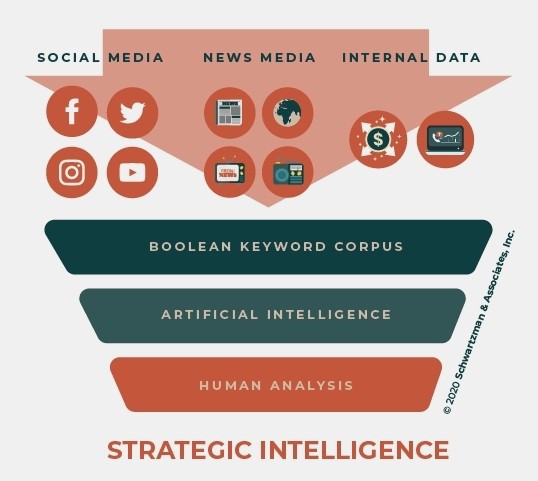With new artificial intelligence and advanced filtering options getting better all the time, it's never been easier to monitor everything that's being said in traditional and social media about companies, brands, and individuals.
But there are literally dozens of media monitoring platforms to choose from, and all kinds of big promises are being made about which of them can do what.
Just evaluating the options is enough to make your head spin. With so much innovation underway, verifying the claims and picking the best solution is a huge amount of work.
The obvious first step is getting clear on why you're monitoring social and traditional media in the first place and what a successful monitoring program looks like for your organization. Are you mostly just looking to track media coverage, or are you monitoring for strategic intelligence?
In the old days, media monitoring services were used to count news clips. Today, media monitoring underpins strategy through "Outside Insight," as Meltwater CEO Jorn Lyssegen puts it in his book about gut-checking your KPIs against external metrics.
The just-completed vendor-neutral 2020 Media Monitoring Buyer's Guide (it's free)—an in-depth, up-to-date analysis of the state of traditional and social news media monitoring, including features comparison chart—can help you in your decision-making process.
In the meantime, in this article I'll discuss—at a high level—what marketers should look for when evaluating media monitoring services so you know what criteria to consider when making that decision.
Breadth of Coverage
This is one of the first things marketers tend to think about when selecting a media monitoring service provider. But it's really only one piece of a three-part puzzle.
Media monitoring services consist of three basic components:
- The first piece of the puzzle is the news feeds they have access to. Which news media outlets do they monitor, how much of their content do they have access to, and are they just getting raw text or do they get photos and any graphics that appear as well?
- The second piece of the puzzle is the interface you use to filter the source feeds. The single biggest cost of switching to a new media monitoring provider is training your staff to use the platform. From this perspective, ease-of-use is a critical factor: The longer it takes for staff to learn to use the system, the higher your cost of implementation.
- The third piece of the puzzle—and this is where I see the greatest potential for gain—are the narrow artificial intelligence filters that can be deployed to help process large amounts of traditional and social media results that may be impossible to review manually.
So, although the source feeds that a platform has access to are an important first piece of the puzzle, without an intuitive interface and machine-learning capabilities, breadth of coverage is all but meaningless.

1. Monitoring the Most Media
Most of the news media monitoring platforms have access to the same source feeds. In fact, many of the media monitoring platforms also license their source feeds to their competitors.
Companies like Critical Mention, Factiva, LexisNexis, Talkwalker, and TVEyes license their source feeds as part of their business model. There may be some platforms that have unique licensing agreements with one or two outlets, but most media monitoring platforms have pretty much the same breadth of content.
And this is further complicated by the fact that almost none of the media monitoring providers make it easy to see which outlets they cover. The only way to get a hard-and-fast answer on who gets what is to prepare a spreadsheet of the outlets you want to monitor, send it to your sales rep, and ask them to manually check to see if they cover them.
If you want to drill down from there and try to figure out how much of each outlet's content they receive, chances are they won't know. And that isn't their fault. There are no standards for how outlets parse their feeds, so there's no easy way to keep track of that information.
For these reasons, basing a decision on breadth of coverage alone is a fool's errand. The second and third pieces of the puzzle—the interface and AI filters—are more important.
2. The Platform Interface
We've long known that ease-of-use drives adoption. The easier a software product is to use, the more people use it and the more successful organizations are at deploying it.
Once you finally have access to more traditional and social media than you could possibly read, how easy is it to filter and process all that data to essentially find the proverbial needle in a haystack?
That's what you want to know.
Boolean Queries
How powerful are the system's Boolean search capabilities? How many operators can be combined in a single query? Is there a text proximity filter? Is there image search? Podcast search?
And after you try out a Boolean query, are the results clean of garbage data, or is there so much crap in there you're going to have to manually review every single result for relevance?
Those are the types of things to test out before you buy.
Here are the 17 most important questions to ask your rep in the 2020 Media Monitoring Buyer's Guide:

Artificial Intelligence
Although there are some promising narrow machine learning capabilities in many of the media monitoring platforms, we are still a long way from artificial general intelligence, which would be capable of cross-domain thinking, natural-language understanding, and truly accurate sentiment analysis.
Go with a platform that allows you to introduce Boolean search parameters prior to introducing artificial intelligence filters to your data set. If you can separate most of the wheat from the chaff manually through Boolean queries first, it may then be possible to introduce some narrow AI filters to further process the data.
Meltwater has spun off an artificial intelligence business unit called Fairhair.ai, which provides APIs for a number of narrow machine-learning filters that can be used to process data on third-party platforms. Those filters include the ability to determine concepts, tag important terms, detect geographical origin, assign sentiment polarity at the sentence level, and derive overall sentiment. Much as other media monitoring platforms license source feeds, Meltwater licenses AI filtering technology as part of their business model.
Cision is working on developing entity-level analysis, which would allow you to tag concepts in articles at the entity level, determine sentiment and complexity over time, going beyond just good, bad or neutral, which it calls automated 3D tagging capabilities.
Look for a solution that allows you to introduce artificial intelligence after Boolean processing and the ability to turn those AI features on and off.
3. The People Behind the Platform
Given that these are such early days for automated sentiment analysis and natural-language processing, and given that there is still so much information buyers need that is not readily available, choosing a provider willing to supplement the gap between product capabilities and performance with training and support is probably the most important thing to consider.
What sort of onboarding program is in place to get you up to speed on the new platform? Getting assigned a dedicated customer success rep is a good start. But is there some sort of structured curriculum in place to take you from a novice to advanced user, and how long does it take to complete that training path?
Review sites are an excellent place to find unbiased, neutral opinions about usability and customer satisfaction. Check out how users rate the platform on G2. The user ratings grid in the 2020 Media Monitoring Buyer's Guide can help you compare, side by side, the providers I reviewed.
Sales reps are trying to hit their numbers. They make well-intentioned promises about how they'll support you. But, I can tell you first-hand, I've had too many experiences where those promises were unmet after I paid a one-year contract. At that point, it's too late.
So take a look at the service agreement and see specifically what the media monitoring platform is committed to providing you with to maintain your business. If there's a knowledge base or online learning platform, ask for access and check it out before you sign the deal.
And if there's any way to figure out their churn rate, that's the most valuable information you can possibly consider. I'd be willing to buy software sight unseen if I had churn rates for all the providers.
The Big Picture
In addition to considering those three important pieces of the puzzle, there's one more important thing to consider when making a media monitoring purchase.
Think about where you currently sit in the hierarchy of your organization versus where you'd like it to sit in the future.
If you want a seat at the boardroom table, you need accurate metrics that...
- Demonstrate the business impact of your marketing efforts
- Can withstand CMO or CFO scrutiny
- Are presented in language the CEO cares about.
That means you need a way to map out the customer journey and understand how awareness becomes opportunity, and how opportunity becomes revenue, and how monthly revenue translates into customer lifetime value.
From a features standpoint, it means you need a way to import external data into your media monitoring platform so you can run comparisons against things like sales, pipeline revenue, stock price, number of applicants for available jobs at your company, share of voice, purchase intent, and even the consumer confidence index.
Intelligence lies at the intersection of multiple datasets. The objective is to triangulate truth against multiple sources, both internal and external. Not all media monitoring platforms allow you to import third-party data. That may be fine if you're not looking to grow your role. But if you are looking for a seat at the boardroom table and you want to evolve media monitoring into media intelligence, this is a key feature you're going to want.




